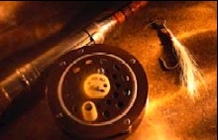Culebra Creek in the San
Luis River Valley in Southern
Colorado.
 |
The waters from this
fishery will traverse thorough the beautiful and scenic San Luis Valley
and eventually flow into the famous Rio Grande. This fishery is Culebra
Creek and it begins
northeast of Sanchez Reservoir, a cool-water reservoir known for
healthy northerns and walleyes. The headwaters of Culebra come from the
western slope of Sangre de Cristo's where the most southern peak in
Colorado that is over 14,000
feet is Culebra Peak. The Culebra and several smaller creeks and streams
all have a northwesterly destination, with many of the smaller creeks
and streams journey ending when
it meets with the Culebra. Slowly it meanders just north of Sanchez
Reservoir. As the cool tailwaters out of Sanchez flow into Culebra, the
creek grows in
size, gently it will oxbow and snake its way through the valley, delicately
craving undercuts along its banks. At times the land allows for shallow gravel
bars, long clear glides and some deep pool stretches. It is this vicinity
where the waters have become and ideal trout habitat. The fish on average are by no means large
in comparison to some of Colorado other tributaries, but they good sized in
relation to the creek's size. Some browns in Culebra are in the 4 and 5 pound
range, but on average you can expect browns and rainbows short of 14 inches.
Overall the Culebra in an excellent quality water
fishery for brown, rainbows, cutbows and a few brooks. Fly fishing does require some descent
level of skill and matching the hatch is as easy checking the grill on your
means of transportation. The Culebra should remain a good fishery
for several reason, the most important being, it is on private land and the Culebra is catch and release only. Please note to fish the creek requires
property owners permission. Some owners do have rod charges, however at the time
of this writing the San Luis Visitor Center was issuing land owner courtesy cards.
Directions: From the Hwy. 159 bridge downstream 3 miles to Jaquez
Bridge:
Restrictions: A. Artificial flies or lures only.
B. All trout must be returned to the water immediately.
About San Luis: San Luis was established on April 5, 1851, presently
its population is just under 1,000. Predominately Hispanic, with strong ties to
cultural and artistic traditions. The town still maintains many buildings of
historic character.
There are couple restaurants and taverns and a general
store, that appears to have been around for several generations.
San Luis also offers several cultural attractions such as the San Luis Museum and
a Cultural Center. Other attractions include the Great Sand Dunes
National Monument, Zapata Falls, Fort Garland Museum, the Cumbres and
Toltec Scenic Railroad.


